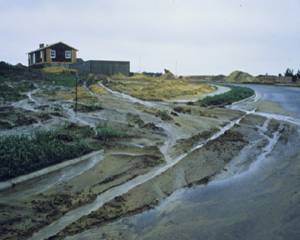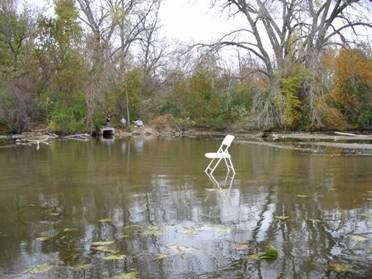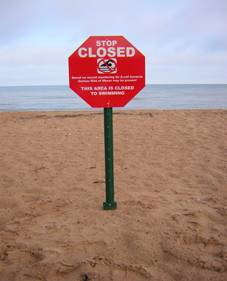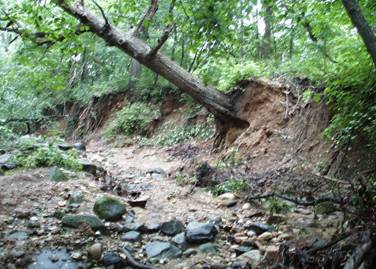Why is Storm Water Runoff a Problem?
LEARN MORE ABOUT STORM WATER RUNOFF
Storm Water Runoff is Not Clean Water
Storm water runoff carries pollutants that can seriously harm our waters. These types of pollutants are commonly found in storm water runoff.
Sediment
During construction projects, the soil is exposed and susceptible to erosion when vegetation is removed from the landscape. Rain falling on bare soils can cause erosion and create storm water runoff carrying soil particles called sediment. Construction sites are one of the largest sources of sediment that can pollute the water resources of Wisconsin. Construction sites without practices to control erosion or settle out the sediment can release 30 tons of sediment per acre.
Sediment deposited in a lake or stream makes the water cloudy or turbid. When sediment settles out of the water, it gradually fills in the stream, lake bed, or wetland and can destroy fish spawning areas and other aquatic habitats. Construction sites are not the only source of sediment. Freeways, industrial sites, commercial sites, institutional and residential development can also contribute significant sources of sediment in storm water runoff.
Microorganisms
Bacteria, viruses and other disease-causing organisms make waterways unsafe for swimming, wading and other types of recreation. Some of these organisms, notably Cryptosporidium, may endanger the health of people who come in contact with lakes and streams high in microorganisms. Sources of bacteria and viruses in urban runoff are pet wastes; bird droppings from pigeons and geese; other urban wildlife (squirrels, chipmunks); and sanitary sewer overflows.
Fecal coliform bacteria counts in urban runoff are often 20 to 40 times higher than the health standard for swimming. Bacteria and other pathogens can wash into swimming areas and create health hazards, often making beach closures necessary.
Phosphorus and Nitrogen
Runoff from both urban and rural areas contains nutrients such as phosphorus and nitrogen. Phosphorus, often carried in with the sediment, fuels the growth of algae and aquatic weeds. Rapid and excessive growth of algae and aquatic plants can degrade water quality and interfere with swimming, fishing and other recreation. When algae die, they sink to the bottom and decompose in a process that removes oxygen from the water. Fish and other aquatic organisms die when dissolved oxygen levels are lowered.
Phosphorus compounds attach to the soil particles in sediment, but phosphorus can also be in a soluble form. Urban sources of phosphorus include lawn fertilizers, pollen, leaves, grass and orthophosphate in vehicle exhaust. One pound of phosphorus can produce 300-500 pounds of algae.
Toxic Chemicals
Motor oil, gasoline, grease, automotive antifreeze, lead from gas and auto exhaust, zinc from roof drains and tires and other toxic chemicals in storm water runoff may kill aquatic organisms or impair their health, growth or ability to reproduce. Road salt mixed with storm water runoff can also be toxic to aquatic life.
Household hazardous wastes like insecticides, pesticides, paint and solvents can poison aquatic life. Land animals and people can become sick or die from eating diseased fish and shellfish or ingesting polluted water.
Oxygen Demanding Materials and other Wastes
Organic materials such as pet waste, leaves, grass clippings and litter in storm water runoff use up oxygen as they decay. After a storm sewer washes this type of organic waste into an urban waterway, it can deplete the oxygen in that waterbody. Fish kills can result when oxygen levels drop.
Debris such as plastic bags, six-pack rings, bottles and cigarette butts washed into water bodies can choke, suffocate, or disable aquatic life like ducks, fish, turtles and birds.
Storm Water Runoff Can Cause Waterway Erosion
Development changes the natural flow of water across the landscape. Construction of new buildings and parking lots in areas that were fields or woods typically reduces infiltration and increases storm water runoff, which leads to flashy flows in area streams during storm events and no flow during dry conditions. Higher flows in streams can create erosion, loss of aquatic habitat and sediment deposition downstream.
When storm water detention/retention facilities are constructed within new development or redevelopment projects, they temporarily store storm water runoff and release it through a designed outlet structure that reduces erosion. Managing the volume and peak flow rate of storm water runoff from new development protects waterways from erosion and sediment deposition.
Other Information
Read more about pollutants in storm water in these reports and fact sheets.
- Sources of Pollutants in Wisconsin Stormwater [PDF]
- Sources of Pollutants in Urban Areas [PDF]
- Polluted Urban Runoff: A Source of Concern [UW extension fact sheet, Exit DNR]
- After the Storm [EPA fact sheet, Exit DNR]
See What can you do to help? for more information on solutions to storm water management and pollution prevention





